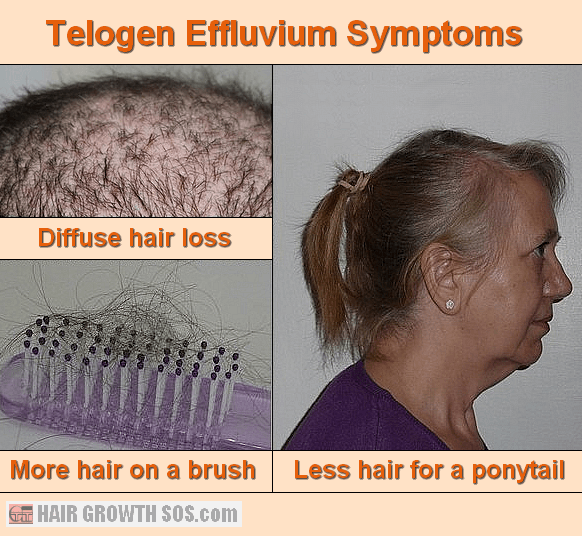Table Of Content

Clinically, when AGA is obvious there would be no difficulty to recognize it. Modest cases are more troublesome, but trichoscopy is of a major help. The ratio between the hair density at the vertex and that at the occiput should be less than 1.49 MWT is a simpler and invaluable diagnostic tool providing a measure of the respective severities. The prevalence of vellus hairs that exceeds 10% indicates AGA that deserves treatment. Two different pathogenetic mechanisms may interact.14 Postpartum TE is an example.
What Are the Symptoms of Telogen Effluvium?
My femininity felt strangely threatened, and I realized my hair had long served as a security blanket. While I may not have loved other parts of my body, I was always confident in my long, wavy hair. If you have telogen effluvium, at least four hairs will come out with each pull. At the visit, your doctor will ask what medicines you take and whether you were sick or stressed in the 3 months before the hair loss started. It may be hard for the doctor to see effluvium if you haven’t lost much hair. They can help determine what’s behind your hair loss and help develop an appropriate treatment plan for you.
Stress Management
Fat injection therapy offers hope for reversing baldness - Earth.com
Fat injection therapy offers hope for reversing baldness.
Posted: Thu, 30 Nov 2023 08:00:00 GMT [source]
I began researching top-rated hair supplements, and ultimately went with Nutrafol—a system that targets the root causes of female hair loss like stress, the environment, and hormones. I completed a mineral hair analysis with the brand’s team of naturopathic doctors, and discovered stress was likely a key factor behind my shedding. Considering the last year I’d lost my job, made the difficult decision to leave New York, moved in with my parents, and then with my new boyfriend, I wasn’t surprised by this result.
Chronic vs Acute
You may be able to pull clumps out of your scalp, or you may notice much more hair on your pillow, in your brush, or collecting in your shower drain. If your hair loss is related to stress, reducing your stress levels may also help. You may wish to start journaling or mindful meditation to help manage your stress. Yoga and other forms of exercise may help clear your mind and offer a healthy way to cope with your stress. Try to treat your hair very gently while you're experiencing hair shedding.
Find out more about how stress can cause hair loss in our article. Telogen effluvium causes hairs to enter the resting stage from the growing stage prematurely. Most people who are healthy lose up to 100 strands of hair per day.
History and Physical
It’s truly hard to know, so some direct viral effect can’t be ruled out, Freeman said. My six-month follow up appointment is still on the horizon, but I can confidently say that my hair has improved. Not only did my three-month appointment go considerably better than the first (no tears this time), I’ve noticed less shedding in the shower and have a respectable crop of baby hairs along my part and crown.
During the telogen part of the cycle, your hair follicles (small tubes in the skin that produce hair) become inactive. These tiny organs may be preparing to grow hair during this phase. The existing hair can remain until the follicle reactivates and creates a new hair that pushes the old one out. With telogen effluvium, it is common for hair to grow back within 3–6 months after managing the cause.
Health conditions
Vitamin D is vital for cell growth and, hence, its deficiency could also be a possible cause of it. Another cause can be biotin deficiency but is reportedly very rarely [11,15]. The primary symptom of telogen effluvium is increased hair shedding or hair loss. The hair loss starts abruptly and tends to last for less than 6 months. Telogen effluvium does not usually cause baldness or permanent hair loss.
Healthcare professionals
If the patient presents during the acute shedding, a gentle pull test yields at least four hairs removed with each pull. However, if the patient presents after the acute shedding has passed, the pull test may be normal. Careful examination of the scalp will show an increased percentage of short anagen hairs growing close to the scalp. The resting scalp club hairs remain firmly attached to the hair follicles at first. The new hairs coming up through the scalp push out the resting club hairs and increased hair fall is noticed 2 to 4 months after the triggering event.
Postpartum Hair Loss: Treatments And Prevention – Forbes Health - Forbes
Postpartum Hair Loss: Treatments And Prevention – Forbes Health.
Posted: Wed, 14 Jun 2023 07:00:00 GMT [source]
Being gentle with your hair while it’s experiencing change is important so as not to exacerbate any thinning. It goes without saying that excessive heat and chemical treatments aren’t a good idea, but try and opt for protective hairstyles too. “Opt for hairstyles that minimize tension on the hair follicles, such as loose braids, buns or ponytails,” advises Gaboardi. “Avoid tight hairstyles and hair accessories that pull on the hair and handle your hair with care to minimise breakage and damage.

It takes 1-3 months for the affected hairs to fall out after their growth has stopped. After a short time, new hairs then grow from the hair follicles as usual. A normal pattern and thickness of hair returns within a few months once these new hairs are established. Telogen effluvium is characterised by the premature shedding of hair follicles in the resting (telogen) phase of the hair growth cycle. When the underlying cause is resolved or the triggering factor is removed, the hair follicles gradually return to the active growth (anagen) phase, and new hair begins to grow.
Knowing hair is heavily influenced by hormones, I wanted to eliminate all possible factors. I’d been considering ditching the pill for a few years anyway, and thinning hair proved to be my tipping point. Sometimes, medication may be needed — like when your doctor detects a thyroid disorder. While topical minoxidil has not been proven to promote recovery of hair in telogen effluvium, it has theoretical benefits. Patients who wish to take an active role in their treatment may choose to use minoxidil.
Although rare, you might notice hair loss in other areas like your eyebrows or pubic region. In any case, telogen effluvium is not permanent, and most people grow all their hair back once their body has recovered. Dermoscopy will show an increased number of short hairs as well as a global thinning of existing hairs with up to 20% variability in caliber. In chronic TE, patients may additionally show many short, normal-caliber hairs in the frontal area. This is in contrast to findings of increased variability in caliber and greater miniaturization in androgenetic alopecia.
Acute telogen effluvium can usually be resolved by removing the underlying causative factors. However, the treatment of chronic telogen effluvium can be challenging for physicians. A few treatment options are available, but standard guidelines for therapy, frequency, and dosage of drugs need to be established. Acute telogen effluvium becomes self-limited if the triggering factor is identified and removed.
Even if your hair loss is hereditary, there are treatments that exist that can help slow or reverse hair loss. If possible, talk with your doctor to address your concerns and rule out any serious underlying medical concerns that may be causing your hair loss. Whatever the cause of your hair loss, seeking medical attention from your primary care doctor or a dermatologist can help you identify underlying causes. Treatments for hair loss are more likely to be successful if started early. It’s important to keep in mind that hair growth is a complex process and multiple tests may be needed to understand what is causing your hair loss.
As a rule, when the patient has not shampooed for some days and the pull test is intensely positive, the number of hairs collected at the MWT exceeds 300. According to Sabouraud (cited by A. Savill47), the fever must be between 39° and 39.5° (ie, 103°F) continuing for about 6 weeks. The amount of hair fall is great, but patients never become quite bald.47 Pathogenesis is obscure, but a vasculitis of the small papillary or peripapillary vessels can be surmised. When AGA coexists, the ratio between the length of anagen and the one of telogen becomes a critical factor for the quality of the hair’s response to the insult. If this ratio is low, as in AGA in which the anagen length is abbreviated, the probabilities that the insult finds keratinocytes with a high mitotic rate are reduced.














